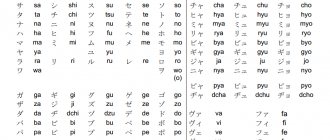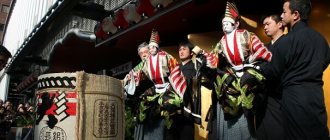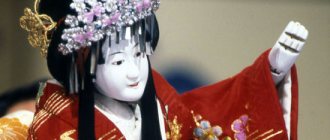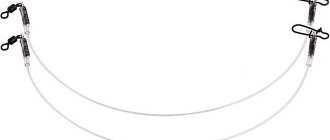Why learn Japanese? 5 reasons to get motivated
Japan is a truly unique country with the highest standard of living and developed economy. It is really difficult to immigrate here, regardless of the purpose of immigration. A prerequisite for obtaining a residence permit is knowledge of the Japanese language. It is difficult to learn, but quite possible.
Let us note at least 5 reasons to start learning Japanese right now:
- The opportunity to immigrate to a country with one of the highest standards of living. Japan ranks 17th in the world in terms of the Human Development Index and 3rd in terms of nominal GDP; the average life expectancy here in 2009 was 82 years.
- Potential to study at one of the best universities on the planet. Tokyo and Kyoto universities are among the best in the world. Thousands of students come to Japan every year, most of them want to connect their lives with robotics and biotechnology.
- An opportunity to immerse yourself in a unique centuries-old culture. The cultural traditions of Japan are at least 3 thousand years old. Learning a language allows you to immerse yourself in it and discover the wonderful world of the Land of the Rising Sun.
- Obvious preferences in employment for relevant vacancies. You will receive a significant advantage when employing companies that do or plan to do business with partners from Japan.
- Personal and intellectual development by 10 points. Studying a language so far from the Cyrillic alphabet will give a powerful impetus to your intellectual development, and its contact with a centuries-old cultural layer will help broaden your horizons.
Interestingly, the Japanese language most often attracts connoisseurs of anime, manga, martial arts and local pop culture. However, over time, a superficial love for Japan develops into something more. In practice, students are much less likely to lose interest in learning Japanese than any European language.
[edit] Worldwide distribution
Most Japanese speakers live in the Japanese archipelago. The Japanese language is partially distributed in those territories that were captured by Japan (Korea[2], Taiwan[2], part of China)[2]. The Japanese language is used by Japanese emigrants in North and South America. Japanese is available for study in schools in most countries in Asia and Oceania. In recent years, with the growing popularity of anime (and Japanese culture in general), it is increasingly being studied by fans of this genre around the world.
Instructions for self-studying Japanese
She will explain in detail how to learn Japanese from scratch at home. All that remains is to supplement it with materials that interest you, select the correct teaching aids and provide regular classes. Remember that learning this language will not happen quickly - on average, even the most talented students take at least 3,000 hours to study to the JLPT N1 level. If you plan to study at home without tutors, feel free to add another 1,500 – 2,000 hours to this time. Do difficulties not scare you? Then proceed to the instructions.
Learn Japanese writing
In Japanese writing, the following are used simultaneously:
- Kanji are characters borrowed from the Chinese and are used to write the stems of words. These are 2,136 standard hieroglyphs and about 500 more “informal” ones.
- Hiragana is a 46-character syllabary used to write particles, unchangeable parts of a word, and some entire words.
- Katakana is a 46-character syllabary used to write borrowed words.
They need to be studied. On average, learning hiragana and katakana takes no more than 12 hours, which means a full week of self-education will be quite enough. With kanji it is much more difficult - hieroglyphs must be learned gradually. Practice shows that to understand half of all kanji in a text, you need to learn 80 kyoiku kanji and 170 of the most popular kanji. If you want to understand more than 90% of what is written, then you need to learn about 1,500 of the most popular kanji - this will take at least 2-3 years.
Start writing in Japanese
At the same time, try not so much to write with a pen on paper as to type. To do this, enable the Japanese layout on your computer and install a special keyboard on your phone (for example, Google-developed “Gboard” or its equivalent). Please note: some extensions allow you to write Japanese words in English letters and quickly convert them into hiragana and kanji later - this option will be especially useful for beginners. Don't forget to also install Japanese fonts in your browser and mobile phone.
Start learning Japanese grammar
In the first stages, the basics will be more than enough. Take any grammar textbook (we will recommend the most popular ones in the list of useful resources) and study it. In the initial stages, it is better to use manuals intended for beginners. The knowledge gained will help you understand the logic of the language and begin to correctly structure words in sentences.
Select dictionaries
They will be vital to you throughout your training. Choose the dictionary you like yourself or use the most popular ones. Please note: if you know English, then it makes sense to use not only Russian-Japanese, but also Japanese-English dictionaries - this will allow you to improve in two languages at the same time. We also recommend installing the Rikaichan browser extension, with which you can quickly translate any word in italics.
Start reading books and watching movies in Japanese
It’s not so important what exactly you watch or read - it could be anime, manga, books, films, popular TV shows or news items. It is better to select Russian or English subtitles for any video - this will help you simultaneously remember the meaning, pronunciation of words and their usual location in a sentence. Beginners are recommended to watch at least 150-200 hours of video in their first year of study.
Expand your vocabulary
Engage in replenishing your vocabulary. Use thematic collections of words, textbooks and mobile applications for this. Write down unfamiliar words when reading the texts of books, articles and songs, try to remember their meaning. First, study the words that Japanese people use most often in speech, and then move on to words and expressions from topics that match your interests.
Communicate with native speakers
This will help you correct your pronunciation and understand the peculiarities of the placement of accents in sentences. Conversations with Japanese will also introduce you to slang words often used in informal communication. You can find native speakers on social networks, popular apps and educational forums.
[edit] History
Like its systematic position, the history of the Japanese language is a highly controversial issue. Proponents of the most common version of the Altai (Puyo) origin of the Japanese language attribute its formation to the period after the conquest of the Japanese Islands by the Altaians (Puyo tribes) - immigrants from the Asian continent, whose language was influenced by the autochthonous Austroasiatics (closest of all related to the aborigines of Taiwan). From an archaeological point of view, this moment may correspond to the emergence of the continental-rooted Yayoi culture (3rd century BC), which gradually replaced the ancient autochthonous Jomon culture. It is difficult to indicate the exact date of the birth of the Japanese nation, since before the introduction of Chinese characters, the Japanese had no written language, and almost no evidence of historical development has survived. Traces of the Japanese people can be traced back to the 3rd century AD. BC, when most of the tribes of Japan submitted to the Yamato clan, although some Chinese sources contain earlier mentions of the Japanese.
Around the 6th century. n. e. (but possibly earlier) there is an active introduction of Chinese culture as a result of diplomatic relations between the Japanese rulers of Yamato, China and the ancient Korean state of Baekje, which was an important center for the export of continental (Chinese) culture to Japan. Along with the advent of government, crafts, culture and art, and Buddhism, writing appeared in Japan. Kojiki and Nihon Shoki are the first major Japanese literary works. During this period, numerous Chinese words appeared in the Japanese language, and to this day, 40% of the vocabulary is made up of Chinese loanwords.
The introduction of Chinese writing created, however, some problems due to differences in stress, use of tones, morphology and syntax of the two languages. From the 7th century Chinese characters are used taking into account the Japanese language format, Japanese morphology and syntax. In the beginning, there was man'yogana - selected Chinese characters that function as a syllabary. In attempts to create a Japanese alphabet (like the alphabet of European countries), katakana and hiragana were created - Japanese syllabary alphabet. A Buddhist monk develops a prototype of modern katakana based on Chinese characters, and in the 8th century. A lady from the Kyoto noble family of Heian creates a second syllabary - hiragana, for writing poems, short stories and diaries. There is little reliable information about who exactly developed these two alphabets; some historians attribute the invention of kana to Kukai. Both syllabaries, in modified form, exist in modern Japanese. By the time the epic “Heike Monogatari” was written in the 12th century, Japanese writing was being formed on the basis of katakana, hiragana and hieroglyphs.
Oral Japanese speech is divided into the following periods: ancient (up to the 8th century AD inclusive), late ancient, or classical Japanese (-XI centuries), middle (XIII-XVI centuries) and modern (from the 17th century to our days). Consecutive changes concern mainly phonetics: of the eight original vowels in modern Japanese, only five remain; the transformations also affected morphology and vocabulary. The syntactic features of the language have undergone almost no changes.
Since ancient times, Japan has had a large number of dialects. In the VI century. the main dialect was Heian Kyo (Kyoto). In the 12th century, the dialect of Kamakura (near modern Tokyo) became the main dialect. By this time, military power was established in the state. Since then, the Tokyo dialect has been the main dialect of the Japanese language.
Until the 20th century, the leading literary form of the Japanese language, with the exception of kambun ("Chinese writing"; a Japanese "version" of the classical Chinese wenyan with Chinese word order and icons that made it possible to read the text in Japanese), went out of use in the mid-19th century. bungo (“written language”), based on the grammatical norms of classical Japanese of the Heian era, but incorporating many phonetic and lexical changes of subsequent centuries.
During the Sengoku era in the 16th century, the Portuguese and other Europeans came to Japan, bringing technology, religion, and Portuguese loanwords appeared in the Japanese language. A little later, a major political figure, Toyotomi Hideyoshi, brought a printing press with movable type from Korea. During the Tokugawa period, book printing developed, population literacy increased, and differences between dialects gradually became equalized. With Tokugawa Ieyasu coming to power in 1603, Japan became a closed country, the authorities prohibited Christianity and contact with foreigners (the only exceptions were Dutch merchants in Nagasaki).
Japanese transcription of a European anatomical treatise (1774)
After the Meiji Restoration, Japan opened contacts with Europe and the United States, and European technologies were introduced throughout the country. Meanwhile, borrowings from English, German and other European languages appear in the language, their pronunciations are adapted to Japanese phonology. During the Meiji period, literature developed rapidly, inconsistencies between oral and written speech were eliminated; The "spoken language" (kogo) movement causes the old written language (bungo) to fall out of use except in official documents (where it remained until 1945) by the 1910s.
Becoming a military power, Japan captured Korea, and during the Second World War - part of China, the Philippines and significant territory in Southeast Asia. The Japanese language is being implanted in these territories. In the older generation, a significant part of the population of the occupied countries retained knowledge of the Japanese language, and Japanese borrowings are preserved in the languages of these countries.
After defeat in World War II, Japan was occupied by the military forces of the anti-Hitler coalition. They proposed a simplification of Japanese writing, which they considered cumbersome, and a translation of the Japanese language into the Latin alphabet. This did not happen, but in 1946 the Ministry of Education of Japan carried out a revision of the hieroglyphs, resulting in a list of 1850 normative hieroglyphs. Since then, the government has maintained strict centralized control over the language and its teaching.
Currently, largely due to the influence of the English language and Western culture, a gap has appeared between the older and younger generations. The new generation of Japanese prefer neutral, informal speech, and little use of the polite and gender-dependent speech of the traditional Japanese language. Thanks to the media, the difference between dialects is gradually decreasing, although thanks to regional identity, dialects persist into the 21st century and also fuel regional slang.
How to learn Japanese on your own? TOP 10 tips
Here are recommendations from teachers, linguists and people who independently learned Japanese at home. Many of them may seem standard, but they will definitely help you systematize and optimize the learning process, making it more comfortable and enjoyable. Use the recommendations provided to avoid mistakes at all stages of the educational process.
1. Learn living Japanese
The language of manga, anime and films can hardly be called “living” - ordinary people don’t speak like that. Therefore, simply viewing/reading and translating is not enough; you must use textbooks, teaching materials and practice communicating with real people as much as possible, take tests, try yourself in writing essays for competitions, and so on.
2. Start by learning syllabaries
Learning katakana and hiragana is the first step to mastering the Japanese language. In total, you have to study 92 characters, which can take from several days to several weeks. Remember that we are individuals and always demonstrate different performance in learning. Difficulties and significant time costs should not cause a loss of motivation.
3. Don't try to memorize all the kanji at once
Memorizing almost 3,000 hieroglyphs is almost impossible. Don’t be surprised, but even native speakers don’t know 100% of kanji, just as Russian speakers don’t know 100% of Russian words. To understand about half of everything spoken and written by the Japanese, knowledge of 1000 kanji is enough, to pass the test at a high level - 1,500-2,000 kanji.
4. Constantly practice your pronunciation
You will have to hone your pronunciation and work on problematic sounds and accents. It won't be so easy at first, but over time you will get used to it and most phonemes will no longer be a shock. Try to listen to Japanese radio and watch Japanese talk shows as often as possible - this will help you find the ideals of “live” pronunciation of words.
5. Don't forget about grammar
It is worth starting to study grammar in the first stages of learning. However, you don’t need to memorize all the rules - start by mastering the manuals for beginners unfamiliar with the Japanese language. Gradually continue to study, and most importantly, understand more complex grammatical basics. Be sure to do this in parallel with expanding your vocabulary and practicing pronunciation.
6. Expand your list of sources
Don’t limit yourself to the manuals, sites and applications you chose at the start, even if you really liked them. Constantly look for new sources of information. There are thousands of textbooks and websites on the Internet dedicated to learning the Japanese language. Try to trust most of all the resources created by professional teachers and those who have learned the language on their own.
7. Connect with like-minded people
Join communities on social networks - here they regularly share links to interesting educational materials, help you find the right textbooks, correct mistakes and give valuable advice. Moreover, you will gain additional motivation for learning, which will be a sense of community and a competitive effect.
8. Immerse yourself in the language environment
Surround yourself with the Japanese language - read news in local media, listen to Japanese radio, music and podcasts, read Japanese prose and poetry, find manga that interests you personally, watch anime. In addition, it is worth finding interlocutors from Japan who can point out your mistakes in pronunciation, word formation and grammar.
9. Be interested in Japanese culture and history
Japan has a rich culture and an amazing, dramatic history. The more interested you are in the life of the country in the past and present, the more motivation to study you will gain. In addition, you will be able to understand the logic of the language and understand the reason for the appearance of many words, which will greatly simplify their learning.
10. Look for opportunities to go on a language tour
Many language schools and even Japanese companies organize language tours to Japan. You can participate in some of them for free (as part of a competitive selection) or with a significant discount. Look for opportunities to go on such tours, write essays for competitions as often as possible. Even if you fail, the benefits from the very fact of searching and writing a resume will be more than tangible.
[edit] Classification
The genetic connections of the Japanese language have not yet been fully elucidated. Japanese can be considered as an isolated language (if it is included in the same group with Ryukyuan - the Japanese-Ryukyu languages). There is also a hypothesis (supported, in particular, by S.A. Starostin) according to which Japanese belongs to the languages of the Altai family, the Buyeo group, along with modern Korean and Buyeo (ancient Korean) languages, with a significant Austronesian substrate and Chinese adstrate. The grammatical structure of the Japanese language is very similar to Korean. And many words of the Goguryeo language (an ancient principality in North Korea) and, to a lesser extent, other Buyeo languages, find parallels in the ancient Japanese language[3].
The vocabulary of the Japanese language can be compared with the vocabulary of Altaic or Austronesian languages. Like Korean, Japanese experienced a strong lexical influence from the Chinese language, however, due to the fact that this influence mainly affected the vocabulary and almost did not affect the grammar, Japanese is not classified as a Sino-Tibetan language.
15 Best Resources for Learning Japanese
We have selected 15 websites, mobile applications and channels that are most often used by students studying Japanese on their own. Check out the following resources:
- Akanji is perhaps the most convenient site for learning kanji.
- A guide to Japanese grammar is a handy guide for beginners (if the site doesn’t open, use a VPN).
- Venasera is a thematic YouTube channel with Japanese language lessons and a lot of interesting videos about Japan.
- Yarxi is a convenient Japanese-Russian dictionary with a lot of additional materials.
- Warodai is another simple Japanese-Russian dictionary with a convenient search form.
- AnkiDroid is a mobile application with flashcards for learning words.
- Memrise is a convenient service for expanding your vocabulary with the ability to listen to words.
- Learn Japanese is a mobile application that is suitable for both beginners and students continuing to learn the language.
- Ichiban - a lot of textbooks, fiction and other materials for learning the Japanese language are collected here.
- Minna no Nihongo – this site contains a lot of books, articles and other interesting texts in Japanese.
- The Land of the Beginning of the Sun is a portal with materials about Japanese word formation and vocabulary.
- Japanese Lessons - a free online course for learning Japanese from scratch.
- First lessons – 40 basic lessons for beginners, the site is completely free.
- Krakozyabr is an interesting site for anyone learning Japanese.
- Doramatv is a site with popular Japanese and Korean dramas and series.
Remember that you should not be limited to the above list - be sure to look for additional resources that will be interesting and convenient for you.
[edit] Dialects
→ Dialects of Japanese
Differences in pronunciation of the colloquial copula だ (
da
) in different regions of Japan
Due to the geographical features of Japan (many isolated islands, high mountain ranges), there are more than a dozen dialects of the language. They differ in vocabulary, morphology, the use of function particles, and in some cases, in pronunciation. Common dialects include Kansai-ben (関西弁), Tohoku-ben (東北弁) and Kanto-ben (関東弁), the dialect of Tokyo and the surrounding area. Speakers of different distant dialects often do not understand each other (even though every Japanese knows standard Japanese). The greatest linguistic differences exist between the southern (Ryukyu Islands, etc.) and northern regions of Japan. The main territory is divided into western and eastern groups. Based on the Tokyo dialect, a “common language” (共通語kyo:tsu:go)
). The standardized dialect began to be studied in educational institutions in 1886. The smoothing of dialectical features is also associated with the active use of common dialects in the media.










